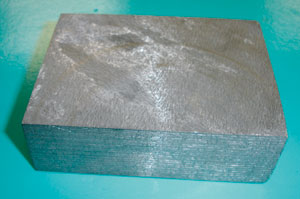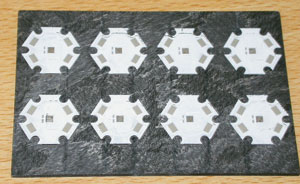ITRI Lab Unveils Superior Metal-composite Substrate for High-powered LEDs
2009/04/03 | By Ken LiuMaterial science expert Dr. Jen-dong Huang knows the importance of the efficiency of thermal-conductivity substrates for light-emitting diode (LED) packaging materials, and has recently unveiled metal-based composite substrates that boast superb conductivity at 200~800 watt/meter Kelvin.
As the manger of the Division of Metallic Materials Research at the Materials & Device Thermal Management Laboratory under the government-backed Industrial Technology Research Institute (ITRI), Dr. Huang notes the inefficiency of LEDs: turning only 15-20% of electrical input into light, with the rest as heat. "If such heat is not effectively exhausted into the ambient air, LED life is shortened with compromised luminosity resulting from excessive heat built-up inside a lighting device," Huang says.

6-years in the Making
Dr. Huang spent about six years on the substrate program before coming up with the metal-based composite formula, noting that metal-based composites are noted for high thermal conductivity and low CTE, meaning they don't expand as much under heat, merits of which have attracted materials specialists worldwide to closely study such materials and create their own formula. Such metal-based materials, he says, are quite helpful to overcome the thermal dissipation issue related to high-density LED packaging.
Dr. Huang's composite materials consist of diamond powder, carbon fiber, graphite, and silicon carbide mixed with aluminum or copper powder, with the formulae being trade secrets. After a number of tests in the ITRI laboratories, Dr. Huang's composite materials have shown outstanding properties, some of which even exceeding those of competing materials developed by global counterparts.
Superior Properties
Besides featuring excellent 200~800W/m.K in thermal conductivity, Dr. Huang's formula effectively limits CTE under 8ppm/K and density under 2.5 grams/ml. "Good thermal conductivity means lesser thermal resistance that facilitates the spread of heat to minimize hot spots on LEDs. Packaging reliability and lifespan is a function of the compatibility between LED device and packaging substrates in terms of CTE. When the two components are basically compatible in CTE, LED device can be directly attached to the substrate to further improve thermal dissipation," Huang elaborates.
When low-powered devices were still mainstream in the LED industry, packagers usually used RF-4 as substrates, Dr. Huang says. Such material, a mixture of fiberglass and epoxy, is rated only 0.3W/m.K in thermal conductivity. Later when one-watt-and-higher LEDs became popular, packagers started pursuing high conductivity and low CTE substrates. So metal-core substrates with aluminum and copper bases have since become predominant thermal-conductivity substrates for packaging.
Dual Conductivity
Such metal-based substrates, while more effective in thermal dissipation, also conduct electricity, so a dielectric layer is needed on their surface as insulation to prevent LEDs from short circuiting, with such insulation being usually a polymer. "Polymer is a good insulator, but also a heat barrier. So a metal substrate coated with polymer has conductivity of only 0.5W/m.K at best. Some manufacturers began adding aluminum oxide, zinc oxide, ceramic and silicon carbide to polymer to boost thermal conductivity," Dr. Huang notes. Adding these fillers to the dielectric layer raises thermal conductivity to 2-3W/m.K but retains CTE at 23ppm/K.
Metal-core substrate is the dominant and most developed packaging material to date. Dr. Huang points out that some manufacturers have "grown" aluminum-oxide layer on aluminum slugs as insulator, raising thermal conductivity to 20W/m.K. "However, aluminum-oxide layer contains too many fissures, exposing it to the high risk of being penetrated by currents from LED electrodes," Huang notes, revealing the weakness of such substrate.

Some substrate manufacturers electroplate ceramic, diamond or aluminum nitride layer as a dielectric on the surface of aluminum slug to boost thermal conductivity. "Although such dielectric layers have obviously improved thermal conductivity, with aluminum nitride being the best at 180W/m.K, the processing costs are quite expensive and their low compatibility with LEDs in terms of CTE limit their maximum area," Huang notes.
Unlike metal-core substrates, Dr. Huang's composite materials boast high CTE compatibility, making them suitable for larger LED packaging for the maximum size can be as big as an A4 paper.
Also boasting cost efficiency, Dr. Huang's composite materials are priced only half as much as equivalents supplied by manufacturers overseas and yet feature certain superior properties. He notes the composites were originally for printed circuit boards. "The composites are quite reliable. The next step is to improve their integration with LED systems such as modules and cases to make them work together properly," he stresses, adding that the materials have won two patents in Taiwan and are patent pending in the United States.




